لنفترض أنك تريد زراعة شجرة. لن تفعل ذلك في أول قطعة أرض تصادفها، أليس كذلك؟
بل ستقوم بالبحث أولاً - ابحث عن تربة خصبة وجيدة التصريف، وابحث عن موقع يضمن لك أشعة الشمس المثالية. هذه هي الطريقة الوحيدة لضمان أن تؤتي جهودك في الزراعة ثمارها. 🍎
وبالمثل، لن تقوم ببناء منتج دون البحث عن احتياجات العميل الذي ستستهدفه. إن تمارين اكتشاف الزبون أو المنتج ضرورية إذا كنت تريد أن يؤتي منتجك ثماره، أي توفير قيمة للعملاء المحتملين وتحقيق النجاح المالي والسوقي.
وبصفتك مديراً للمنتج، فإن الطريقة التي تتعامل بها مع مقابلات اكتشاف العملاء يمكن أن توجهك نحو القرارات التجارية الصحيحة. يجب عليك أن تطرح الأسئلة الصحيحة لاستخراج المعلومات المهمة بما يكفي لتشكيل منتجك.
في هذه المقالة، سنشاركك أسئلة اكتشاف العملاء التي نطرحها للمساعدة في إنشاء منتجات جديدة أو تعديل الحلول الحالية. ستجد أيضًا نصائح وأدوات للمساعدة في جعل عملية الاكتشاف فعالة وكفؤة.
ما هي أسئلة اكتشاف العملاء؟
أسئلة اكتشاف العملاء هي أسئلة تطرحها على العملاء العملاء أو العملاء ل اكتشاف وفهم احتياجاتهم - خاصة تلك التي لم يتم تلبيتها بعد. يُشار إلى كل حاجة لم يتم تلبيتها على أنها نقطة ألم.
تساعد نقاط الألم فرق المنتج في التحقق من افتراضاتهم حول السوق، وتقدير مواصفات المتبنين الأوائل للمنتج، والتركيز على تطوير شيء مفيد ومقبول في آن واحد. 💗
اكتشاف العملاء: المفهوم والعملية
اكتشاف العميل هو عملية التعرف على العملاء المستهدفين حتى تتمكن من بناء منتج يخدمهم بشكل أفضل، ويحفز مشاركتهم ويحقق مبيعات جيدة.
وعادةً ما تبدأ العملية بإنشاء شخصية المستخدم تصور مجموعة ديموغرافية محددة واحتياجاتهم الوظيفية والنفسية ذات الصلة. بعد ذلك، تستخدم أسئلة استكشافية لجمع المعلومات من المشترين الفعليين وتنقيح الشخصية أثناء تقدمك. في معظم الحالات، تتم مشاركة البيانات مع فرق المطورين الذين يعملون على المنتج.
لا تتوقف عملية الاكتشاف مع إطلاق المنتج على الرغم من أن احتياجات العملاء تتغير بمرور الوقت. عليك استخدام أدوات التحليلات لجمع الرؤى في الوقت الفعلي في سلوك العميل وتكييف المنتج وفقًا لذلك من أجل الاحتفاظ بعملائك .
نصيحة: استخدم قوالب ClickUp المجانية لتبسيط عمليات استكشاف العملاء أو الإنتاج. من استراتيجية المنتج إلى القوالب الشخصية للمستخدم ، يمكنك العثور على أكثر من 1000 مستند منظم مسبقًا مع ميزات إدارة البيانات المدمجة لتسريع سير عملك.
على سبيل المثال، يمكنك استخدام قالب نموذج الاتصال بالعميل ClickUp لجمع وتنظيم الردود من أبحاث السوق واستطلاعات الرأي في مكان واحد.

استخدم قالب نموذج الاتصال بالعملاء ClickUp للحصول على تشكيل حول نقاط ألم العملاء ومطالبهم
العلاقة بين العميل واكتشاف المنتج
إن اكتشاف العميل واكتشاف المنتج مفهومان مترابطان بإحكام ولكن لهما أهداف مختلفة.
فبينما يتمثل الهدف من اكتشاف العميل في فهم الاحتياجات غير الملباة للفئة السكانية المستهدفة، فإن اكتشاف المنتج يتعلق بـ تحديد المنتج الذي يلبي تلك الاحتياجات. كما أنه يركز على الكيفية - الطرق التي يجب أن تستخدمها لتطوير المنتج أو تعديله والحفاظ على ملاءمته.
الطرق الشائعة لاكتشاف العملاء
يمكنك الحصول على رؤى العملاء بعدة طرق
- مباشرة من العملاء: الاحتفاظ بسجل لمشاكل العملاء عن طريق:
- إجراء مقابلات مباشرة مع العملاء مع الأفراد والمجموعات المركزة
- توزيع نماذج الملاحظات عبر الإنترنت للوصول إلى جمهور أوسع
- الاستفادة من الاستماع الاجتماعي لمراقبة المناقشات عبر الإنترنت حول منتجك
- عبر الاكتشاف الداخلي: اطلب رؤى من فرق المبيعات وممثلي دعم العملاء الذين يتفاعلون مع العملاء يوميًا
- من خلال تحليلات المنتج: العديد منأدوات إدارة المنتج تتضمن ميزات مثل تسجيلات الجلسات والخرائط الحرارية لمساعدتك على تصوررحلات العملاءوتتبع أنماط الاستخدام، واكتشاف مناطق المشاكل
- بواسطةتحليل المنافسين وتوجهات الصناعة: اكتشف ما يفعله منافسوك الرئيسيون وقادة الصناعة ولماذا. احرص على تقديم نفس القيمة (أو أكثر) وابتكار طرق للاستفادة من نقاط ضعفهم
أسئلة اكتشاف العملاء الخبراء التي يجب طرحها
في الأقسام الأربعة التالية، سنقترح عليك بعض الأسئلة التي يوصي بها الخبراء والتي يمكنك طرحها على العملاء المحتملين (شخصيًا أو عبر الإنترنت) لفهم نقاط ضعفهم بشكل أفضل. يمكنك تعديل الأسئلة لتتناسب مع منتجك أو التركيبة السكانية الخاصة بك.
1. أسئلة تتعلق بنقاط ألم العميل وأدواره ومهامه اليومية
اطرح هذه الأسئلة المفتوحة لملاحظة كيف يمكن أن يكون منتجك مفيدًا للعميل:
- ما هي وظيفتك الحالية ومهامك الأساسية؟:_ ستوجه الإجابة على هذا السؤال المهم مفهوم وتطوير منتجك. يكشف السياق الذي سيستخدم فيه المنتج في أغلب الأحيان
- ما هي نقاط الألم الرئيسية التي تواجهها في الوقت الحالي؟: تُظهر المشاكل الحالية للعميل أين تقصر المنتجات الحالية. يجب أن يحل منتجك بشكل مثالي هذه المشاكل المحددة
- ما هي أكبر التحديات التي تواجهك عند محاولة القيام بعملك؟: على الرغم من أن هذا السؤال مشابه للسؤال السابق، إلا أنه يمكن أن يكشف عن المشاكل التي لا تظهر على الفور، مما يساعدك على إنشاء حلول شاملة
2. الأسئلة المتعلقة بالحلول الحالية
لفهم المنتجات التي تنافسها، اسأل ما يلي:
- ما هي الأدوات التي تستخدمها حاليًا لحل المشاكل الخاصة بعملك؟:_ من خلال هذا السؤال، يمكنك تحديد أكبر منافسيك. هدفك هو إما أن تكمل الأدوات الحالية أو تتفوق عليها من خلال توفير حل أمثل
- ما الذي لا يعجبك في الحلول التي جربتها؟: الإجابة على هذا السؤال ستحدد أوجه القصور لدى منافسيك. ستعرف الأخطاء التي يجب البحث عنها والميزات الجديدة الانتهازية التي يجب الانتباه إليها عندتصميم منتجك نصيحة: كيف تصمم منتجًا متفوقًا؟ استخدم قالب تتبع المنافسين ClickUp لتتبع منتجات منافسيك وميزاتهم وأسعارهم.
3. الأسئلة المتعلقة بوجهة نظر المستخدم لمنتجك
بمجرد أن يصبح منتجك جاهزًا للتشغيل التجريبي، استخدم الأسئلة أدناه لجمع الملاحظات الأولية:
- ما مدى سهولة استخدام هذا المنتج؟: البديهية وسهولة الوصول هما المعياران الأولان اللذان سيحكم عليهما المستخدمون. إذا لم يكن منتجك سهل الاستخدام، فإن المزيد من المستخدمين لن يتشجعوا على استكشافه، بغض النظر عن عدد أو جودة ميزاته
- هل هناك أي ميزات جديدة تفضل أن يحتوي عليها هذا المنتج؟: يكشف هذا السؤال عن أي ميزات قد تكون أغفلتها أو ميزات إضافية يجب عليك تضمينها
- إذا كان بإمكانك تغيير أي شيء في هذا المنتج، فماذا سيكون ذلك؟: اسأل عن الميزات التي يتطلع العملاء أو شريحة معينة من العملاء إلى تعديلها، ودوّن سبب الإزعاج
4. أسئلة لاكتساب رؤى قيمة أخرى
استفد مما يلي للحصول على ملاحظات أكثر تفصيلاً حول منتجك:
- ما مدى احتمالية أن توصي بهذا المنتج لزميل في العمل أو صديق؟: يمكّنك هذا السؤال من تحديد مستويات رضا المستخدم
- هل جرّبت أي حلول بديلة قبل هذا المنتج؟: افهم ما الذي يميز منتجك عن غيره وما الذي جعل المستخدم يتحول إليه. كما يكشف أيضًا عن معايير المستخدم العادي لتقييم المنتجات في هذا المجال
- هل هناك أي ميزات لا تستخدمها؟: بينما يجب أن يكون منتجك شاملاً، يجب أن يكون بسيطًا أيضًا. إذا كانت إحدى الميزات لا تقدم قيمة، يجب عليك إما مراجعتها أو إزالتها. لكن كن حذرًا. في بعض الأحيان، لا يكون السبب الجذري للمشكلة هو الميزة نفسها بل اعتمادها. في هذه الحالة، ما عليك سوى تقديم المزيد من المساعدة لمستخدمي المنتج الجدد
- هل هناك أي شيء يمكن أن يجعلك تتوقف عن استخدام المنتج؟:_ هذا السؤال قيّم لأنه يحدد الإشارات الحمراء التي يجب البحث عنها. فهو يسمح لك باكتشاف المشاكل المحتملة ومعالجتها قبل حدوثها
متى يتم إجراء مقابلات اكتشاف العملاء
يجب طرح أسئلة اكتشاف العملاء بشكل مثالي طوال دورة حياة تطوير المنتج. نظرًا لأن السوق ديناميكي والعديد من المتغيرات غير المتوقعة يمكن أن تؤثر على تفضيلات العملاء، فمن الضروري تقييم آرائهم بشكل مستمر و بدء جهود تحسين المنتج .
في مرحلة ما قبل الإطلاق، ضع فرضيات حول احتياجات العملاء المستهدفين - أسئلة مقابلة اكتشاف العملاء التي ناقشناها من قبل تعمل على اختبار فرضياتك.
بمجرد أن تعرف ما الذي يجب التركيز عليه عند تصميم منتجك، انتقل إلى مرحلة النماذج الأولية. اطلب رأي العملاء مرة أخرى عندما تقوم بإنشاء نسخة مبكرة من المنتج. تتيح لك هذه العملية فهم ما إذا كان المنتج يحل مشاكلهم بالإضافة إلى الشكل والمظهر المناسبين.
بعد الإطلاق، الهدف من هذه الأسئلة هو توفير مبادئ توجيهية لتحسين المنتج و نجاح العملاء . يمكنك:
- ضبط الميزات وتجربة المستخدم
- معالجة نقاط الألم الحالية التي ربما فاتتك من قبل
- معالجة تحديات الاستخدام التي ظهرت في هذه الأثناء
سيسهل اكتشاف العميل المناسب أيضًا عملية التجزئة . ستتمكن من فهم شرائح المستخدمين المربحة لتنفيذ استراتيجية تسعير مخصصة أو تقديم تجارب أكثر تخصيصًا.
إذا صممت منتجك وحسّنته مع وضع العملاء في الاعتبار، ستضمن استمرار ملاءمة المنتج للسوق ورضا العملاء. كما أنك ستمهد الطريق لفعالية تسويق المنتج واحصل على هذا الكلام الشفهي 🗣️
أدوات لإجراء اكتشاف العملاء
يمكنك جعل عملية جمع بيانات العملاء وتحليلها أكثر كفاءة باستخدام الأدوات المناسبة، مثل:
أدوات الاتصال ومؤتمرات الفيديو ### أدوات الاتصال ومؤتمرات الفيديو
تتيح لك هذه الأدوات التواصل مع العملاء, جدولة المقابلات وإجرائها. على الرغم من أن المحادثات الشخصية مفضلة لإجراء مقابلات مع العملاء، إلا أنها ليست ممكنة دائمًا، لذا فإن عقد مؤتمرات الفيديو هو ثاني أفضل شيء. 📹
الاستطلاعات والاستمارات والاستبيانات
إذا كنت بحاجة إلى جمع كميات كبيرة من بيانات العملاء، فيمكنك القيام بذلك عبر الإنترنت من خلال أدوات الاستبيانات والاستبيانات أو توزيع أوراق الاستبيانات في الفعاليات الصناعية.
أدوات الاستماع إلى وسائل التواصل الاجتماعي
تسمح لك أدوات الاستماع على وسائل التواصل الاجتماعي بمراقبة قنوات التواصل الاجتماعي بحثاً عن الإشارات إلى منتجك أو شركتك، وقياس التصور العام والرد على أي إشادات أو مخاوف بسرعة.
مكافأة: استخدم كليك أب قوالب الوسائط الاجتماعية لتبسيط حملاتك على الإنترنت. ستحب فرق التسويق الخاصة بالعلامات التجارية ذات التواجد المكثف على وسائل التواصل الاجتماعي ClickUp نموذج سير عمل استراتيجية وسائل التواصل الاجتماعي لجدولة المحتوى وتحليل مقاييس الأداء.
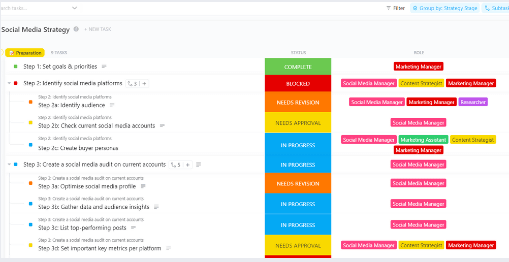
استخدم قالب سير عمل استراتيجية وسائل التواصل الاجتماعي القابل للتخصيص من ClickUp لتخطيط وإنجاز المهام المهمة المتعلقة بوسائل التواصل الاجتماعي
أدوات إدارة علاقات العملاء (CRM) برنامج إدارة علاقات العملاء بمثابة مركز يمكنك من خلاله تخزين وإدارة جميع بيانات العملاء التي جمعتها، بما في ذلك
- معلومات الاتصال
- سجل الشراء
- ملاحظات المستخدم
- الشكاوى
أدوات إدارة المنتجات والمشروعات
اكتشاف العملاء هو جهد معقد وجماعي. تنسيق جميع المهام المعنية عبر فرق المنتج والتسويق باستخدام برنامج إدارة المشاريع . تساعدك هذه الأدوات على تبسيط سير عمل الاكتشاف، وتبقيك على الجدول الزمني المحدد، وتساعدك على تتبع التقدم المحرز.
ClickUp: أداة واحدة لاستبدالها جميعًا
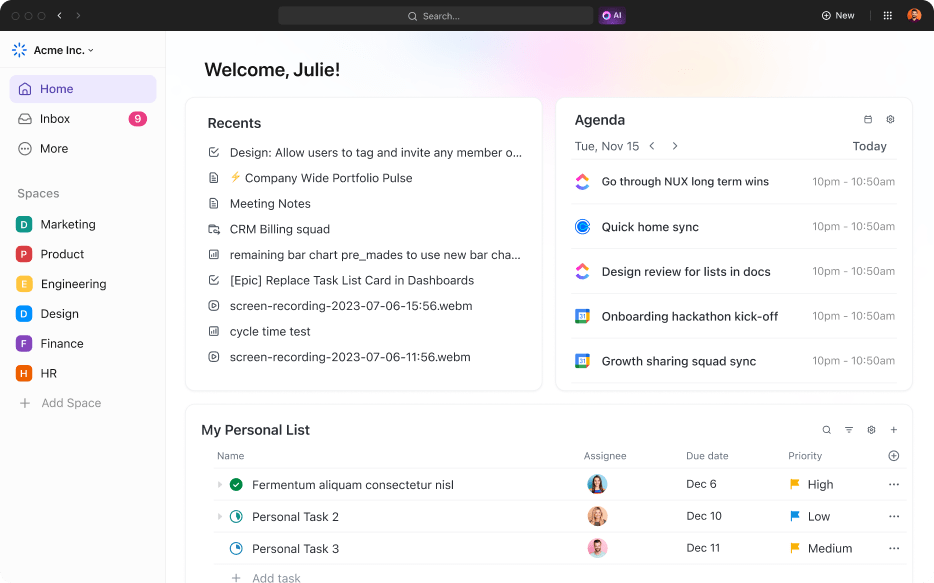
استخدم ClickUp لتخطيط تمارين اكتشاف العملاء وتنظيم جميع المعارف في مكان واحد
بدلاً من التبديل بين جميع هذه التطبيقات والأدوات، لماذا لا تستخدم انقر فوق ? إنه حل عمل مجاني ومتعدد الاستخدامات لمديري المشاريع والمنتجات على حد سواء! يمكن أن يساعد ClickUp في إدارة المنتجات واكتشاف العملاء طوال دورة حياة المنتج - بدءًا من مرحلة التفكير الأولي وحتى ما بعد الإطلاق. 🌸
الاستخدام مهام النقر فوق المهام لتخطيط وتنسيق العمل عبر أقسام البحث والتسويق. يوفر ClickUp أيضًا العديد من أدوات الاتصال المدمجة، مثل عرض الدردشة و التلميحات لتعزيز فهم واضح لسير عمل الفريق.
يمكنك الاختيار بين أكثر من 15 مشاهدة لتخصيص مساحة العمل الخاصة بك. على سبيل المثال، استخدم عرض اللوحة لتخطيط جهود الاكتشاف الخاصة بك عبر مراحل المنتج أو استخدام عرض التقويم لجدولة مقابلات 1-1 مع العملاء.
مع نماذج ClickUp يمكنك إنشاء استطلاعات رأي مخصصة للعملاء وتوزيعها عبر القنوات ببضع نقرات. إذا كنت لا تريد أن تبدأ من الصفر، فاستخدم أحد نماذج ClickUp العديدة قوالب الاستبيانات للبدء. يمكن لـ ClickUp تحويل الإجابات تلقائيًا إلى مهام - قم بمراقبتها في عرض الجدول ومتابعة الميزات المطلوبة أو مشكلات المستخدم الشائعة.
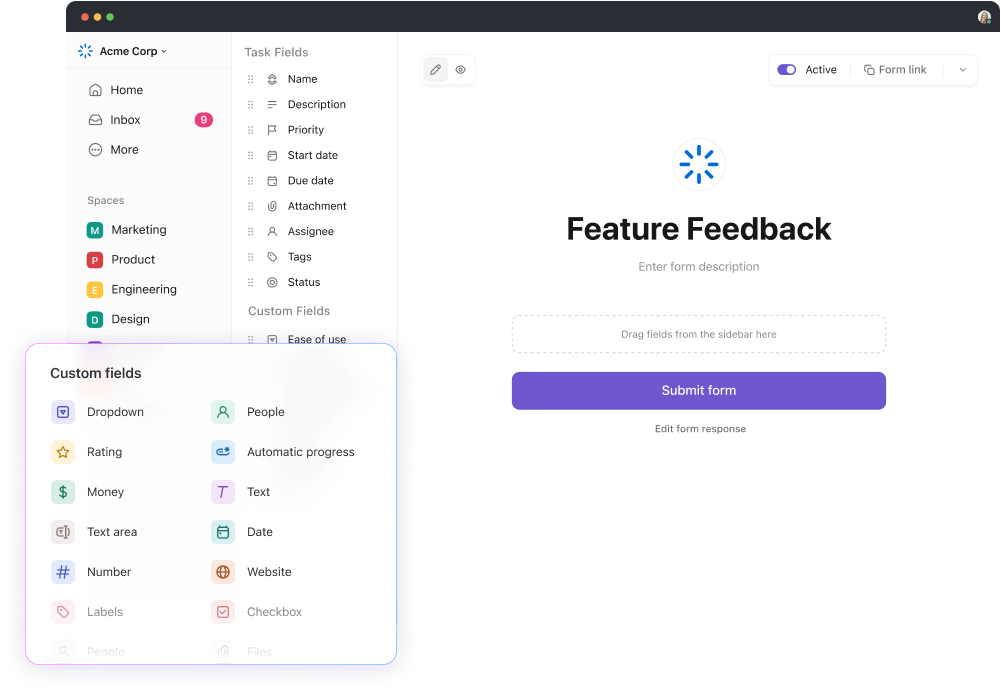
باستخدام ClickUp Forms، يمكنك إنشاء الاستبيانات المثالية لجمع آراء العملاء حول المنتج
ClickUp CRM للحفاظ على التوافق مع أهداف رضا العملاء مجموعة ClickUp's CRM Suite تساعدك على إدارة معلومات العملاء وخطوط المبيعات والطلبات والحفاظ على علاقات أقوى مع العملاء.
بالنسبة للمبتدئين، يمكنك تنظيم جميع بيانات العملاء واستراتيجيات المنتجات الخاصة بك مع مستندات ClickUp . قم بإنشاء وتنقيح شخصيات العملاء على الفور بفضل منصة مساعد الذكاء الاصطناعي -ClickUp Brain. استفد من المطالبات الجاهزة لتطلب من الأداة توليد:
- شخصيات المستخدم المثالية
- الدراسات البحثية
- قصص المستخدمين
- أسئلة اكتشاف المنتج
- ملخصات المحتوى
يمكنك أيضًا إجراء عصف ذهني باستخدام الأداة وتوليد أفكار لتحسين المنتج! 💡

يمكن أن يوفر لك ClickUp AI الوقت والجهد من خلال إنشاء شخصيات العملاء ومتطلبات المنتج والمستندات الأخرى بدلاً منك
هل تحتاج إلى تصور رحلات المستخدم مع فريقك؟ ClickUp Whiteboards تُمكِّنك من رسم خريطة لرحلات العملاء على لوحة سهلة الاستخدام والسحب والإفلات. استخدم الميزة مع قادة فريقك لتحديد الاختناقات ووضع استراتيجيات التحسينات بشكل استباقي.
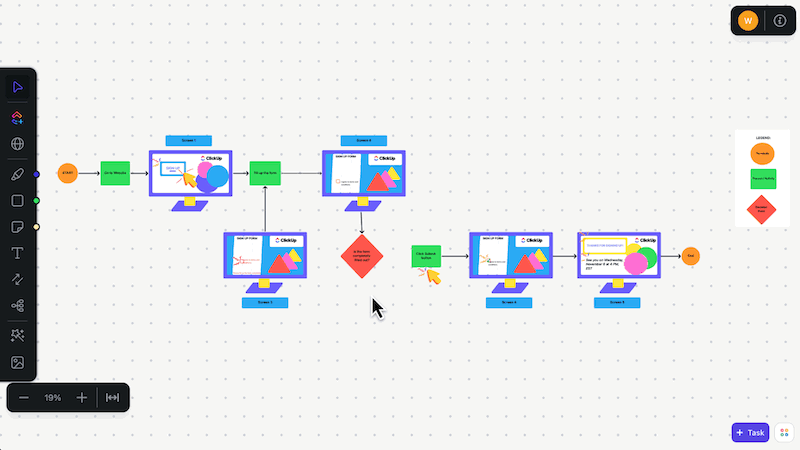
أنشئ خرائط جذابة لرحلة العميل وخطط للخطوات التالية مع زملائك في الفريق باستخدام ClickUp Whiteboards
يمكنك أيضًا تعيين أهداف إطلاق المنتج وتتبعها على لوحة مخصصة لوحة معلومات ClickUp -استخدم أكثر من 50 بطاقة لعرض جميع مقاييس العملاء والمنتجات في لمحة سريعة.
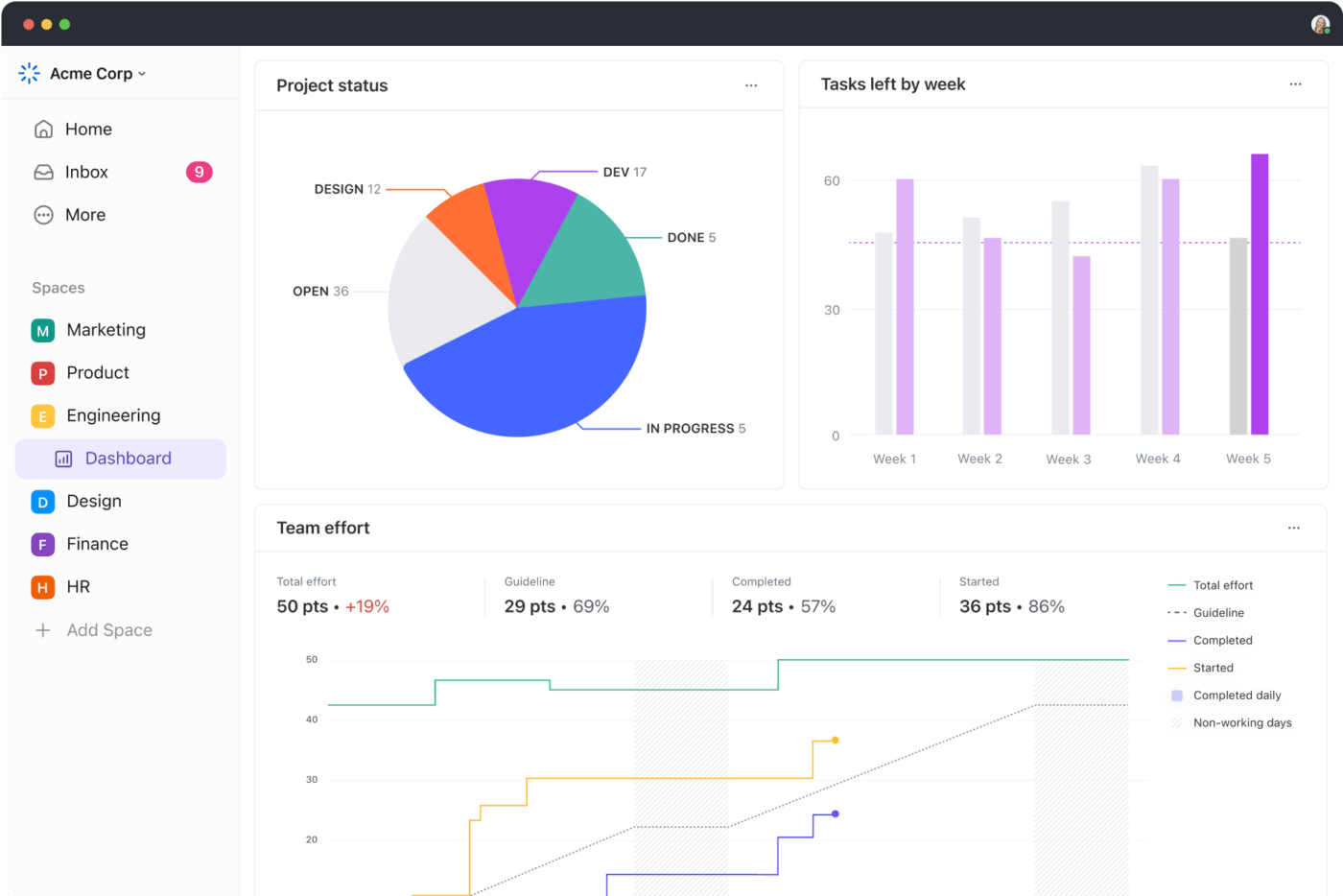
أنشئ لوحة معلومات ClickUp المثالية وتتبع التقدم والأداء وتحليلات العملاء في لمحة سريعة
إن أفضل ما في ClickUp هو أنه يتكامل مع أكثر من 1000 أداة، بما في ذلك مزودي خدمات البريد الإلكتروني وبرامج الاجتماعات، مما يضمن إمكانية الوصول إلى جميع تطبيقاتك من مكان واحد.
ما يجب فعله وما لا يجب فعله لاكتشاف العملاء
اتبع النصائح أدناه لتحقيق أقصى استفادة من جهود اكتشاف العملاء.
افعل: قم بإعداد وتوثيق كل شيء
ضع هدفًا واضحًا في ذهنك عند التواصل مع العملاء لمعرفة أكبر قدر ممكن عنهم. قم بصياغة قائمة الأسئلة بعناية والتزم بها لتجنب إضاعة وقتهم. ⌚
أثناء المحادثة، قم بتدوين جميع الملاحظات ذات الصلة. نظّم المعلومات بدقة حتى تتمكن من الوصول إليها بسهولة فيما بعد.
افعل: اجعلها محادثة ودية
كن ودوداً عند إجراء المقابلات الشخصية مع العملاء. ابتسم واكسر التوتر الأولي ببعض الأحاديث القصيرة. على الرغم من أنك ستخوضها بنية محددة، إلا أن المحادثة لا يجب أن تشعر العميل بأنك تستجوبه. بهذه الطريقة، سيكون العميل المحتمل أكثر استعدادًا للانفتاح وتقديم رؤى قيمة. 🤝
لا: كن خائفًا من الرفض
سماع الكلام السلبي عن فكرة منتجك مؤلم، ولكن استمع باهتمام إلى مشاكل العميل عندما يشتكي.
فكّر في الأمر بهذه الطريقة - إذا كانت افتراضاتك خاطئة، من الأفضل أن تسمع الأخبار في المراحل الأولى بينما لم تستثمر بعد قدرًا كبيرًا من الوقت والمال والجهد في تطوير المنتج و الحملات التسويقية .
لا: الإفصاح عن الكثير أثناء المحادثة
لا تبالغ في الإفصاح عن الهدف من المقابلة. على سبيل المثال: _سيستخدم مديرو المنتجات لدينا إجاباتك لتطوير تطبيق جديد
قد يؤدي الإفراط في المعلومات إلى جعل العميل يشعر بالعبء وعدم الارتياح، وقد يرفض مشاركة أفكاره الصادقة.
المسار السريع لاكتشاف العملاء والمنتجات باستخدام ClickUp
يُعد اكتشاف العملاء خطوة حاسمة في بناء المنتجات وتحسينها. عندما يكون اتخاذك للقرار مدعومًا بالأدلة، فمن المرجح أن يزدهر منتجك وعملك التجاري. 🌟
باستخدام أدوات مثل ClickUp، لا يمكن أن يكون اكتشاف العملاء مثمرًا فحسب، بل يمكن أن يكون مبسطًا أيضًا. احصل على الحل المجاني اليوم وابدأ في فتح رؤى العملاء في أسرع وقت.

